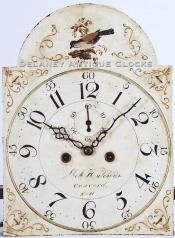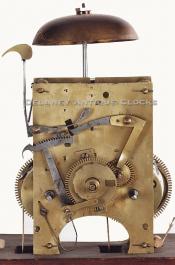Abel Hutchins of Concord, New Hampshire. A fine inlaid mahogany case tall. 210064.
This decoratively inlaid mahogany case features typical New England proportions. The case is primarily constructed in mahogany and is decorated with several nicely formatted inlays. This combination is unusual for this inland clockmaker, suggesting that this case was a special order for a savvy client.
This is a very nice formal example. It stands on four flared French feet. The feet transition upwards into a drop apron that hangs from the base section. This apron features multiple drops and is visually separated from the base panel by a decorative line inlaid banding. This banding starts at the back edge of the case side and continues to the front of the case, across the base panel, and then returns to the back of the case across the side. The base panel features a wonderful selection of crotch veneer. This panel of veneer is positioned vertically, making the case look long and narrow. It is framed with an inlay pattern formatted with a series of small consecutive boxes arranged in a line pattern. Next, a cross-banded mahogany border is trimmed along the outer edge with a barber pole-style string pattern. These details are excellent. Many of these design elements are incorporated into the layout of the waist. The waist section is long and is fitted with a large rectangular-shaped door. The door is trimmed with an applied molding. The crotch veneer selected for this panel is not as linear as the one used in the base section. It has more curves along its length. It is also framed with inlay and a cross-banded framing. The front corners of the waist section are fitted with finely reeded quarter columns. These terminate in brass quarter capitals. Additional inlay patterns are displayed above and below each column. The bonnet or hood features a New England-style fretwork pattern. This pattern is quite complex in that the design is long and lacy. Three reeded chimney plinths support three brass ball-and-spike finials. The two bonnet forward columns are also reeded and flank the bonnet door. These are mounted in brass captious. Smoothly turned quarter columns are positioned at the back of the hood. The side panels are fitted with tombstone-shaped side lights. These and the arched hood door are fitted with glass. The bonnet door opens to access a colorfully painted dial.
This iron dial is of Boston origin and was most likely manufactured by the Nolen & Curtis dial firm. Urns are depicted in each of the four spandrel areas. These are surrounded by raised gesso decorations that are highlighted in gilt paint. In the arch of this dial is a colorful bird. Additional raised gilt work can also be found in this location. The time ring features Arabic-style hour numerals. Smaller Arabic numerals are used to mark each of the five-minute positions. A subsidiary seconds dial is located in the center of the dial. The Maker’s name is signed in a large script format above the hour numeral “6”. The city location of “CONCORD / N. H.” is signed in a block format.
The movement is constructed in brass and is weight-driven. It is designed to run eight days on a full wind and strike each hour on a cast iron bell. The striking system features a rack and snail setup. The cast iron bell is mounted above the movement. The movement is of good quality.
This clock stands approximately 7 feet 7 inches tall to the top of the center brass finial and was made circa 1810.
Able Hutchins worked with his older brother Levi in partnership from 1783 through 1803. Both boys were born in Harvard, Massachusetts. Levi was born on August 17, 1761, and Abel was born two years later in March. Both men lived long into their nineties! On December 6, 1777, the brothers entered into an apprenticeship with Simon Willard of Grafton, Massachusetts. At this time, Levi was sixteen, and Abel was fourteen years old. After serving their indenture to Simon, both boys moved to Concord, New Hampshire, sometime before 1784. Here, they began what must have been a very productive business making clocks. In 1803, Abel bought out his brother’s interests in the partnership and continued making clocks in the same location. This clock must have been made after this 1803 date. It was most likely made circa 1810.
Inventory number 210064.
Levi Hutchins was born in Harvard, Massachusetts, on August 17, 1761, and died peacefully on June 13, 1855. He was 93. His remains were interned in the Friends' burial ground in Concord, New Hampshire. Interestingly, this was a society he somewhat withdrew from several years before his death. Levi was one of eleven children. His parents were Colonel Gordon Hutchins & Dolly or Dorothy Stone. Levi had a younger brother named Abel, born in March of 1763. He also became a clockmaker and, for a time, worked with his brother in a partnership. Able died in the town of Concord on April 4, 1853. Both men lived into their nineties and lived long, prosperous lives. I have listed some of Levi's life's highlights below.
In 1772, their father moved the family from the town of Harvard, MA, to Concord, NH. In Concord, he purchased land and buildings and commenced as a storekeeper. Gordon became active in the revolution and served as a Captain in the local regiment. Young Levi served in his regiment as a Fifer from April to September 1775. In May of that year, Gordon Hutchins marched to Breeds Hill under the command of Colonel John Stark. Young Levi accompanied them and watched the battle from a distance high on the hills of Medford, MA. Levi also witnessed the burning of Charlestown. His father, Gordon, was later stationed at Winter Hill until the end of that year. Levi enlisted in Captain Lewis' Company, in Colonel Varnum's Regiment, under General Green. In the spring of 1776, he marched to New York under the orders of General Washington to protect the city. He was posted in Brooklyn for a while. He remained posted on the island of Red Hook, which is located 4 miles from New York and is situated to protect the harbor until the defeat of the Americans in the battle of Long Island. Levi was honorably discharged and returned to New Hampshire on horseback.
Levi was well educated. He attended Byfield Academy for one year and Andover Academy for two quarters. He was then recruited as a school teacher and taught in Tewksbury, Pembroke, and Ashburnham, Massachusetts.
On December 6, 1777, the two brothers entered into an apprenticeship with the ingenious Grafton, Massachusetts clockmaker, Simon Willard. At this time, Levi was sixteen, and Abel was fourteen years of age. After Levi served his 3-year indenture to Simon, he traveled to Abington, CT, to serve an eight-month apprenticeship in the watch repair trade.
Levi may have moved to Concord, New Hampshire, as early as 1782. Here he set up a residence and shop on Main Street in the central village. His first shop was very near the railroad passenger depot, not far from the junction of the Merrimack River and the roads from Boston, Portsmouth, and the Connecticut Valley. Soon after Levi arrived, his brother Able moved up from Roxbury, MA, having worked with the Willards for a few years. Together they formed a partnership that lasted until about 1803 and became the most prolific clockmakers in the Concord region for a number of years. Based on the number of examples that trade in the marketplace, their output of tall case clocks was substantial. The earliest known advertisement helps date their partnership. It was published in 1788 in the New Hampshire Spy. They placed an ad in the Concord Herald in 1790 and again in 1792, looking for two apprentices. It is thought that Peabody Atkinson and Jesse Smith answered the ad and trained under them. Both men are recorded as working as farmers in Virginia in their later years.
On February 23, 1789, Levi married Phoebe Hanaford, daughter of Benjamin, and Ruth Hanaford of Haverhill, MA. Together they had ten children. Levi made each one of them a clock before he passed.
In 1793, Levi and Abel purchased a farm three miles away on the western side of Rattlesnake Hill. Here they continued to manufacture clocks and also began to farm.
In 1807, their partnership was dissolved. Abel bought out Levi's share of the business and paid off all debts. Levi received the farm and opened his own shop opposite Gale's Tavern. Abel retained the house and original shop, and the parcel of land. On Tuesday, November 25, 1817, these buildings were consumed by fire. Two years later, Abel erected the Phoenix Hotel.
In 1808, Levi purchased a house on 70 acres, including an apple orchard, a dilapidated fort, a large barn, a woodshed, and later a sawmill located on Long Pond in the West Parish or West Concord Village.
After the War of 1812, in about 1815, Levi built a large building and set up five looms to manufacture cloth. The cloth business lasted three years before it became unprofitable and sold off. One room in this barn was used for clockmaking. Levi continued to work on brass clocks for 20 years. The sawmill operated for 50 years.














